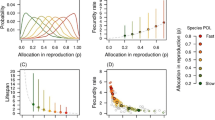Summary
Reproductive value (RV) and net reproductive output (R o) are frequently used fitness measures. We argue that they are only appropriate when intervals between reproductive events are fixed, as they are dimensionless generation-to-generation scalings with units offspring per parent. A fitness measure should account for two different effects of a decrease in generation time: (1) increased survival due to shorter exposure to mortality agents and (2) increased frequency of reproduction.R o andRV deal with the first of these two effects, while a measure with a physical dimensionper time [T−1] is needed to account for the second. The Malthusian growth parameter,r, meets this requirement and in situations where time to reproduction is variable, we proposeρ, the instantaneous rate of spread of descendants (from an individual) be used instead ofR o. As an alternative toRV, we suggest using the instantaneous difference Ф = ρ −r, wherer is the population rate of increase. WhileRV andR o are dimensionless ratios, Ф, and ρ areper time rates which are appropriate in accounting for alterations in generation time.
Similar content being viewed by others
References
Aksnes, D. L. and Giske, J. (1990) Habitat profitability in pelagic environments.Mar. Ecol. Prog. Ser. 64, 209–15.
Caswell, H. (1989)Matrix Population Models. Sinauer, Sunderland.
Charlesworth, B. (1980) Evolution in age-structured populations. InCambridge Studies in Mathematical Biology. Cambridge University Press, London, UK.
Charnov, E. (1990) On evolution of age at maturity and the adult life span.J. Evol. Biol. 3, 139–44.
Clark, C. W. and Levy, D. A. (1988) Diel vertical migration by juvenile sockeye salmon and the antipredation window.Am. Nat. 131, 271–90.
Cole, L. C. (1954) The population consequences of life history phenomena.Q. Rev. Biol. 29, 103–37.
Fisher, R. A. (1930)The Genetical Theory of Natural Selection. Clarendon, Oxford, UK.
Gilliam, J. F. and Fraser, D. F. (1987) Habitat selection under predation hazard: test of a model with foraging minnows.Ecology 68, 1856–62.
Keyfitz, N. (1968)Introduction to the Mathematics of Population. Addison-Wesley Publishing Company, Reading, UK.
Lande, R. (1982) A quantitative genetic theory of life history evolution.Ecology 63, 607–15.
Lewontin, R. C. (1965) Selection for colonizing ability. InThe Genetics of Colonizing Species (H. G. Baker and G. L. Stebbins, eds), pp. 77–94. Academic Press, NY, USA.
Lotka, A. J. (1925)Elements of Physical Biology. Williams & Wilkins Company, Baltimore, USA.
Mangel, M. and Clark, C. W. (1988)Dynamic Modeling in Behavioral Ecology. Princeton University Press, Princeton, USA.
McLaren, I. A. (1963) Effect of temperature on growth of zooplankton and the adaptive value of vertical migration.J. Fish. Res. Board Can.,20, 685–727.
Murray Jr, B. G. (1985) Population growth rate as a measure of individual fitness.Oikos 44, 509–11.
Nur, N. (1984) Fitness, population growth rate and natural selection.Oikos 42, 413–4.
Sibly, R. M. and Calow, P. (1986) Why breeding earlier is always worthwhile.J. Theor. Biol. 123, 311–9.
Stearns, S. C. (1992)The Evolution of Life Histories. Oxford University Press, Oxford, UK.
Stenseth, N. C. (1984) Fitness, population growth rate and evolution in plant-grazer systems: a reply to Nur.Oikos 42, 414–5.
Stephens, D. W. (1981) The logic of risk-sensitive foraging preferences.Anim. Behav. 29, 628–9.
Werner, E. E. and Gilliam, J. F. (1984) The ontogenetic niche and species interactions in size-structured populations.Ann. Rev. Ecol. Syst. 15, 393–425.
Author information
Authors and Affiliations
Rights and permissions
About this article
Cite this article
Giske, J., Aksnes, D.L. & Førland, B. Variable generation times and Darwinian fitness measures. Evol Ecol 7, 233–239 (1993). https://doi.org/10.1007/BF01237741
Issue Date:
DOI: https://doi.org/10.1007/BF01237741




